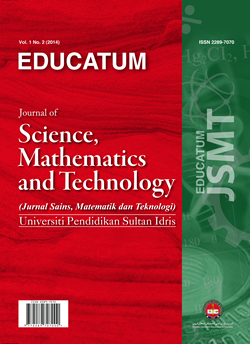An Analysis of Voice-Controller’s Implementation in Teaching DLP Form-One Mathematics: A Case Study
DOI:
https://doi.org/10.37134/ejsmt.vol9.2.1.2022Keywords:
Voice controller, Oral communication strategy, mathematics communicationAbstract
This case study aims to analyze voice-controller (VC)’s implementation of five, national-type secondary schools, Kinta Utara, Ipoh, Perak, teachers in teaching mathematics form-one (T1) Dual Language Programme (DLP). VC consists of three elements: sound level and voice level practice (SL-VL-P); marker and voice level practice (M-VL-P); and activity and voice level practice (A-VL-P). Students’ voice level barrier disturbs teaching and learning. Teacher should control students’ voice level. This study contributes an alternative classroom control strategy for teachers and reflection to Secondary School Standard Curriculum planner about learning and facilitating’s situation in school from communication perspective. Data collection methods were teaching observation, interview, and document analysis. Content analysis method was used to analyze data. The research’s findings indicate the number of participants who had the VC’s goal: cognitive domain (five), affective domain (four), and psychomotor domain (none). Affective domain’s level is limited within receiving and giving response. In VC implementation: (i) The number of participants who implemented SL-VL-P using: routine class explanation (three), reminder (five), oral order (two), repeated conversation (two), blame (one), positive provocation (one), and questioning (two). (ii) The number of participants who implemented M-VL-P using: voice tone (three), body language (three), and teaching aids (none)(iii) The number of participants who implemented A-VL-P using: group size plan (two), activity’s voice level explanation (one), oral order (two), motivation (one), and questioning (two). ‘Giving reminder’ is the common way for all participants. No formal VC drill for students. Two participants faced problem in implementing VC. Conclusion: Five participants’ VC goals are not holistic. Five participants implemented VC undirectedly. There are students unable to perform VC. Implication: Teachers should: (i) plan holistic goals. (ii) plan formal VC. (iii) help students who suffer from voice level barrier. Future study is required to study the relation between voice-level practice and student’s ability to control voice-level.
Downloads
References
Alten, S. R. (2014). Audio in media. Australia: Wardsworth Cengage Learning.
Amin, Aney Marinda Muhammad, Othman & Norasmah (2019). Pengurusan bilik darjah guru baharu yang mengikuti Program Pembangunan Guru Baharu (PPGB). Malaysian Journal of Education, 44(1),21-27.
Bulunuz, N., Bulunuz, M., Orbak, A.Y., Mulu, N., & Tavsanli, O.F. (2017). An evaluation of primary school students’ views about noise levels in school. International Electronic Journal of Elementary Education, 9 (4), 725-740.
DeVito, J. A. (2007). The interpersonal communication book. Boston: Pearson.
Floyd, K. (2022). Communication matters (ed. ke-4). New York: McGraw-Hill.
Gura, T. & Powel, B. (2019). Oral interpretation (ed. ke-13). New York: Routledge.
Hamilton, C. (2018). Communicating for results: A guide for business and the professions. USA: Wadsworth Cengage Learning.
Kementerian Pendidikan Malaysia (KPM) (Ministry of Education Malaysia) (2018). Garis panduan pelaksanaan Dual Language Programme (DLP) di sekolah-sekolah Kementerian Pendidikan Malaysia mulai tahun 2018. Kuala Lumpur: Bahagian Pembangunan Kurikulum.
Kleinman, P. (2015). The science of the mind: Psychology facts and basics. U.S.A.: Advantage Quest.
Massonnie, J., Frasseto, P., Mareschal, D., & Kirkham, N. Z. (2022). Learning in noisy classroom: Children’s report of annoyance and distraction from noise are associated with individual differences in mind-wandering and switching skills. Environment and Behavior, 54(1), 58-88.
Moses, E. & Malani, I. (2019). Dual Language Programme: The perceptions and challenges of teachers and students I Klang, Selangor. Jurnal Pendidikan Sains dan Matematik, 9(1), 36-48.
Mratinkovic, A., Piestun, D., Fouda, H.S., Killings, F., Hajj, S.E., Parveen, F., … Obtained, S. (2018). Illustrated handbook of managerial communication. New York: 3G E-Learning.
Nadiah Has Bullah & Melor Md Yunus (2018). Teachers’ perception on the implementation of Dual Language Programme (DLP) in urban schools. Asian Social Science, 15(1), 24-31.
Nagro, S. A., Fraser, D. W., & Hooks, S. D. (2019). Lesson planning with engagement in mind: Proactive classroom management strategies for curriculum instruction. Intervention in School and Clinic, 54(3), 131-140.
Nashrah Talib, Khalijah Mohd Nor, Masliza Mohd Razali, Nurbariah Ahmad, Siti Rosnita Sakarji & Wan Aisyah Amni Wan Mohd Saferdin (2017). The importance of lecturer voice elements in classroom learning process. Journal of Global Business and Social Entrepreneurship, 3 (6), 23-31.
Ochoma & Marilyn U. (2019). Teacher’s voice quality and teaching effectiveness. African research Review, 13(3), 141-148.
Pantaleon, K.V., Juniati, D. & Lukito, A. (2018). The oral mathematics communication profile of prospective mathematics teacher in mathematics proving. Journal of Physics: Conference Series, 1108, 1-2.
Shannon, & Weaver. (1949). The mathematical theory of communication. London: University of Illinos Press.
Tubbs, S.L., & Moss, S. (2006). Human communication: Principles and contexts. Boston: McGraw-Hill.
Vygotsky, L.S. (1978). Mind in society: The development of higher psychological processes. Cambridge: Harvard University Press.
World Health Organization. (WHO, 2010). (t.t). Noise. Diperoleh daripada https://www.who.int/Europe/news-room/fact-sheets/item/noise#:~:text=How%20Loud%
is%20too%20loud,good%20teaching%20and%20learning%20conditions
Yin, R.K. (2014). Case study research: Design and methods (ed. ke-5). Thousand Oaks: Sage.
Downloads
Published
Issue
Section
License
Copyright (c) 2022 Kenny Chin Aik Kang, Mohd Faizal Nizam Lee Abdullah

This work is licensed under a Creative Commons Attribution-NonCommercial-ShareAlike 4.0 International License.





